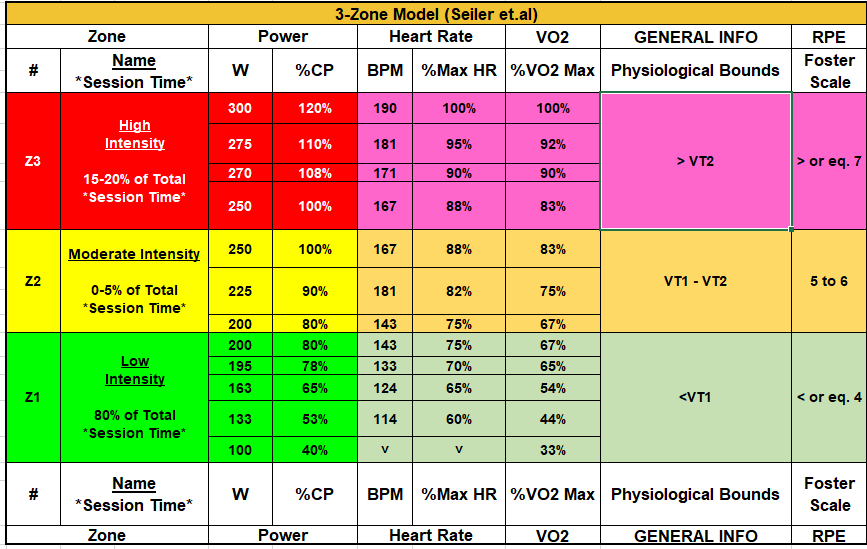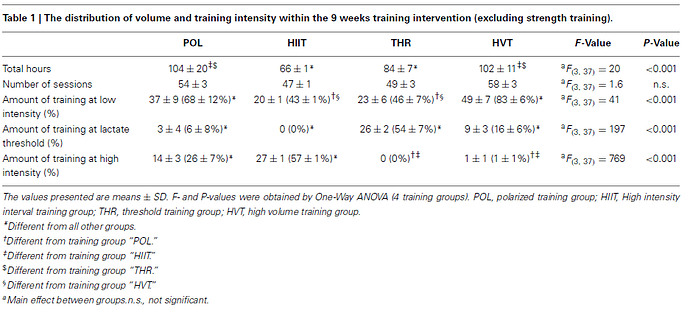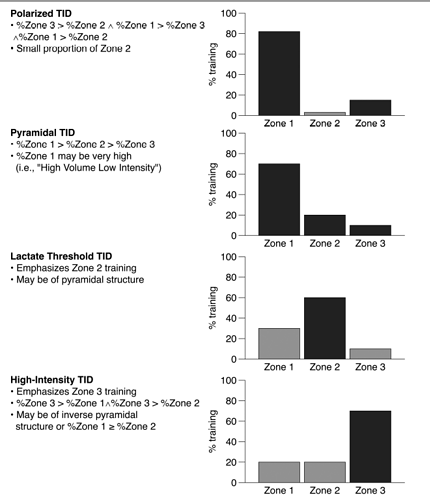Time in Zone by Power numbers, yes.
It’s difficult to correctly identify S1/S2/S3 when doing shorter intervals. Heartrate is rising to slowly when starting that hard interval, hence the different % Power/HR.
Heartrate during shorter hard effort, goes S1–>S2–>S3 while actually should all be S3. It’s better to identify Power corresponding to VT1 VT2 limits.
And Polarized training should be looked at over a period of at least a week. One session isn’t telling you anything.
Thanks.
The way I interpret Dr. Seiler is that he is okay with using % of total weekly session time as a second approach. He seems to prefer the number of sessions approach. So in his analysis of past descriptive studies, he has concluded that a common intensity distribution was quote :
“80% of training sessions are LIT intensity and the remaining are performed as ThT or HIT. For an athlete training 10 to 14 times per week, this means that two to three of these sessions would be ThT or HIT training bouts.”
Thanks.
One session won’t tell you much about long term distribution. I think Intervals.ICU is the first time I’ve seen training classification based on a single days worth of work. But its probably good to keep that in the tool, for those who like to focus on the micro details and work outwards. In theory, if all the single sessions are polarized for example, your week should end up being polarized.
Thanks John. I have yet to check out the spreadsheets.
I made one for my purpose real quick to map a 7-zone CP model to a 3-zone model, based on power, HR, RPE etc. All based on published guidelines and for a hypothetical athlete.
Athlete weight : 75kg
CP : 250W. Assume established from 1/time 2-parameter model
HR@ CP : 180bpm
Max HR : 190bpm
First, the 3-zone model :
Here is the 7-zone CP model :
Conclusions if you go by power output as metric :
-
Upper end of Z1 in 3-zone model = 200W. This region corresponds to Z1 upto a tiny excursion into Z3 in 7-zone CP model.
-
Lower end of Z3 in a 3-zone model = 250W. This region corresponds to top half of Z4 and above in a 7-zone CP model.
Therefore, the much despised Z2 in a 3-zone model overlaps with top half of Z3 and lower half of Z4 in a 7-zone CP model. Going by the guidance, that looks to be somewhere between MLSS intensity (~field correlate FTP) to CP (boundary of very heavy and severe domains where drastic metabolic disturbances are found to take place).
I’m getting a better perspective on things after I did this mapping. I need to share this with Dr. Skiba and just get some of his thoughts as well.
This spreadsheet is available for anyone , please request it if you need it to play around.
Tx guys for all of this and for @Mike_Lauder for digging up the Intervals.icu rules. I am currently riding 5 days a week so glad to hear that more than one of those can be hard and that time-in-zones is “ok” for some definition of ok!
FYI. With reference to hierarchical TID between POL and HIIT, Stöggl and Sperlich (2014) classified the following as POL and HIIT. Note that 68/6/26 was still POL according to them. That’s close to your 50/10/30 example. Would Intervals.ICU classify that as HIIT? Please clarify.
I have heard Seiler say more than one time that people get too focused on the exact specification and percentages. The actual physiology is somewhat cruder. Focus on having some, hard/intense work (~ 20% of sessions) and keep the rest easy.
Even what is categorized as hard/intense is dependent on the athlete and their goals. For some, hard may be threshold or even just sub-threshold work (e.g. triathletes) for others it’s harder stuff.
Anyway, that’s how I keep myself from going insane. 
Thats also POL in Intervals.icu.
This one is HIIT.
I hadn’t seen that before.
50, 10, 30, of course, isn’t right as it only adds up to 90%!
50, 10, 40 is classified as HIIT. but would satisfy the POL criteria.
Mike
Thanks. So there’s a small deviation in the approach for HIIT as considered in literature (S3>S1 | S3>S2) but probably an isolated case. I’ve personally never fallen into this bucket.
Good to have this clarified and documented. I’ll need to bookmark this thread for later reference 
+1. Our discussions on POL vs non POL training is centered just mostly just on intensity and power output. I don’t feel its correct, we need to bring other things into the picture and find a way to integrate. Part of the reason to map 3-zone to 7-zone is also to capture things other than power output.
What is “easy” and what is “hard” is known to most people, they’ll tell you that in a couple of seconds after the fact. The closest metric that achieves that perception is RPE. This is just another reason why we need to integrate the sRPE based load and stress information into intervals.ICU. See my previous thread on this : https://forum.intervals.icu/t/towards-load-strain-based-on-10-pt-session-rpe-rating/2936/3
So then, you end up with a precisely calculated TID according to the classification in the algorithm but also a crude but highly subjective form of “easy” and “hard” in terms of sRPE load and strain. And my hypothesis is that most serious athletes will have “fun” when a) training is not overly easy but b) training is also safe yet athlete challenged just to the right level.
Can we then think of a way to combine the two metrics and provide an index of polarization to user? Not sure, but this needs more research.
Here’s a hypothetical case :
Athlete A had a fantastic week of POL training. Good amount of volume in Z1, lots of variation so less monotony and training just right in Z3 so stressed just right. Eating well and resting well.
Week TID & RPE strain = POL, 1000.
Athlete B had a disastrous time after a week of POL training. Lots of volume in Z1 yes but high monotony, tried Z3 and nearly twisted an ankle on training day and unable to cope well with the training.
Week TID & RPE strain = POL, 1500.
Certainly, I’m no coach. Just a ‘serious’ amateur with a day job, family and no hobbies other than cycling …  I’ll leave the complicated math to others!
I’ll leave the complicated math to others!
I don’t remember which one, but on one of the FastTalk podcasts with Dr. Seiler they spoke about intervals. He prescribes very simple interval workouts, his favourite being the 4 x 8 min workout. He also prescribes shorter and longer variations of the same, like 4 x 4. When asked how hard the athlete should go for the 4 or 8 or 10 min he just said ‘as hard as you can!’ Essentially the athlete has to pace themselves to JUST BARELY be able to complete the 4 intervals. No power as a percentage of anything or zone is specified. The duration of the interval will naturally dictate that. He also says that relatively little rest is required between these intervals, usually less than the interval itself. Once again, not very prescriptive.
Of course, Seiler works with young, highly-motivated professional athletes that have the discipline and understanding of their capabilities to pull that off. Me? Maybe not. For me I’ve created a series of un-complicated workouts for myself that follow this ‘simplicity’ ethos, but help me do the right thing at the right time in my season (in terms of energy system targeted, intensity and duration).
I apologize for the digression! 
I’ve tried this and it matches my lab tested LT1 HR within a beat or two!
Yeah I’ve listened to that podcast too, it was a series of 3. When he analyzed the different time intervals he said the 4x4 was the worst for consistency (ie. athletes being able to achieve similar power outputs over all intervals), 4x8 was the best. With the rest intervals, his analysis was that once you’ve rested “enough”, resting for longer doesn’t actually improve performance.
Yes! Makes you wonder about all those complicated, fancy-looking workouts many coaches or training platforms prescribe …
Yeah, in one of his other podcast/interviews he said that those elite athletes tend to do the same simple workouts over and over. I think the complex ones are more for giving less disciplined athletes some variety to keep it interesting
That’s what I’ve done. I’ve created a small number of simple workouts that target different energy systems that I use at different stages of my season and I just use them over and over again. For sure it doesn’t provide much variety, but I usually execute them in Zwift or outdoors, so that provides the distraction factor for me.
Also, the meaning of ‘intensity’ varies for me - early on it will come in the form of sub-threshold work twice a week (my ‘20%’ of sessions). Later I’ll do actual threshold work and only really reach into the true POL Z3 stuff (120%+ of FTP) in the 4 or so weeks prior to my ‘A’ events given that it doesn’t take much to build that system especially once you have a solid base foundation. This works for me as my events tend to be in the 100 to 180km range. I’m no crit racer!
Not a digression at all. This study you mention is one of the Dr. Seiler’s highly cited studies into interval training adaptations using an iso-effort protocol.
The gold nugget in that paper is one statement within the Discussions section, which most people do not talk about but you bring up rightly.
“We also found that RPE of the interval training programs was more strongly associated with work intensity than accumulated duration.”
This bit right here takes the cake. As I mentioned before, we need to find a way to bring RPE into the weekly TID analysis to provide an overall picture of the “how hard” part and help facilitate a conversation between coach and athlete.
I’ve written the HOW-TO part, now someone just needs to help make that happen.
As for the 4 x 8 mins at 90% HR, if you map it to the 3 and 7-Zone map in my map above, you’ll see it clearly falls in the Z3 and S3 areas respectively. Those looking for a “bang for the buck” HIIT workout for POL training can experiment with incorporating 4 x 8 min intervals as part of the HIIT.
The exact protocol was 2 days of 4 x 8 minutes with 2 minute recoveries, in addition to 2-3 weekly endurance sessions at low intensity, for a total of 5 days/week of training. Clearly this was Polarized.
The study lasted 7 weeks.
+1. My takeaway was this.
-
For a HIIT session, the shortest intervals with the highest RPE didn’t confer the same benefits as slightly longer intervals at lower RPE in recreational cyclists.
-
The study was done on 35 trained recreational cyclists. I have some reservations about extending the findings of this paper to highly trained and elite athletes; the latter section tends to have different recovery characteristics and different training needs to elicit performance gains. Not sure if Dr. Seiler ever thought of repeating said study in a different class of athletes.
Thanks. There are “levels” to periodization of Polarization, if you will.
Currently its an interesting question how the intensity levels can and should progress but I suspect this will always be what works for n=1’s main event. You can either :
- Keep LOW at the same level and increase HIGH as race approaches with volume reduction.
- Intensify both LOW and HIGH with volume reduction, since VT1 and VT2 could right shift over time.
- Or you try a mixed approach between both based on how you are adapting (“adaptive” strategy)
There are no cookie cutter methods as you highlight.



